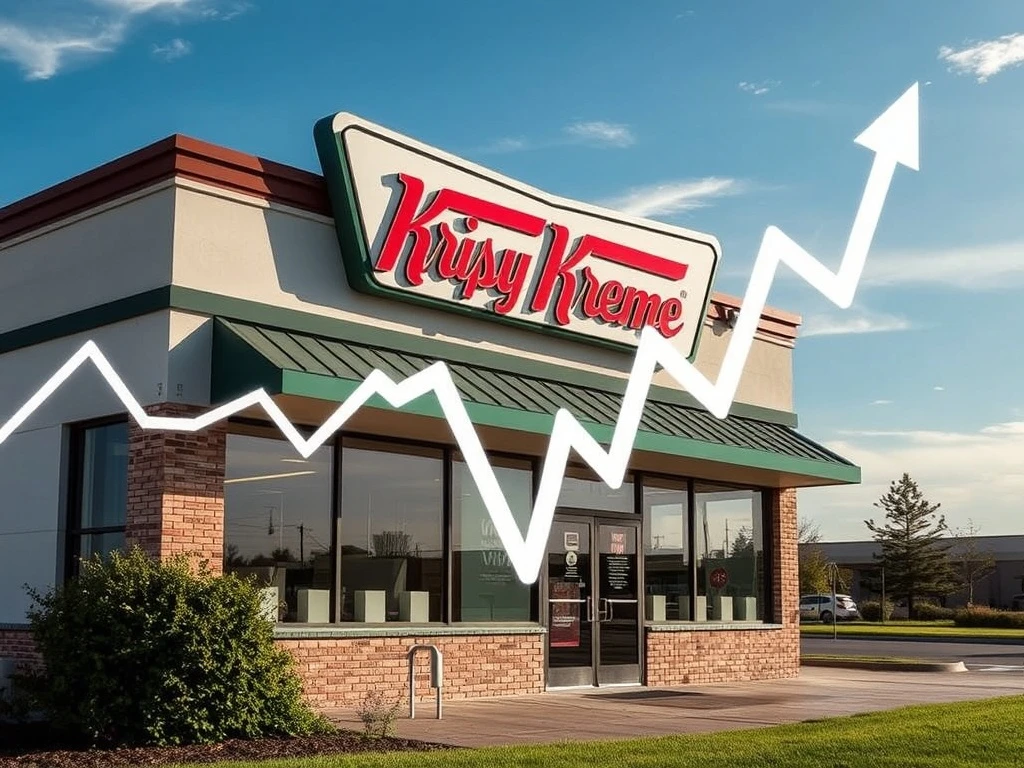For entrepreneurs and business enthusiasts, the allure of a “meme stock” can be compelling. Companies like GameStop and AMC saw their shares skyrocket, driven by social media fervor rather than traditional fundamentals. However, that exciting ride appears to be over. The company’s shares are now facing significant pressure, prompting investors to re-evaluate its long-term prospects. Indeed, this shift marks a crucial moment for the beloved donut chain and its stakeholders. Understanding these dynamics is vital for anyone tracking market trends, especially regarding Krispy Kreme stock.
The Rise and Fall of Krispy Kreme Stock
Krispy Kreme’s journey back to the public market in 2021 was met with considerable excitement. Many investors hoped for a sweet return. Initially, the Krispy Kreme stock did experience some upward momentum. This was partly due to its recognizable brand and a general appetite for consumer discretionary stocks. However, its brief flirtation with meme-stock status was fleeting. Unlike some other meme-driven equities, Krispy Kreme’s underlying financial performance did not sustain the speculative interest. Consequently, the stock began its descent.
Indeed, the company’s share price has seen a consistent decline since its post-IPO highs. This downturn reflects a broader market re-evaluation of growth stocks. Furthermore, it highlights specific challenges facing the donut giant. Analysts are closely watching key indicators. These include sales figures, operational costs, and profit margins. Crucially, each plays a significant role in determining investor confidence. Ultimately, the market is now focusing on fundamentals rather than fleeting trends. This transition has proven difficult for Krispy Kreme stock.
Understanding Krispy Kreme’s Financial Performance
A primary driver behind the current downturn in Krispy Kreme stock is its financial performance. The company has reported widening losses in recent quarters. This trend raises concerns among investors. For instance, despite increasing revenues, profitability remains elusive. Operating expenses have climbed, impacting the bottom line. This includes costs related to expansion and marketing initiatives. While such investments are often necessary for growth, they must eventually translate into profits. Otherwise, they become a burden.
Consider these key financial points:
- Revenue Growth: Krispy Kreme has successfully grown its top-line revenue. This indicates strong brand recognition and sales efforts.
- Widening Losses: Despite revenue gains, net losses have expanded. This suggests challenges in managing costs and achieving efficiency.
- Debt Levels: The company carries significant debt from its expansion efforts. High debt can pressure future earnings and limit flexibility.
- Operational Efficiency: Improving operational efficiency is crucial. This could help turn revenue into profit.
These factors collectively weigh heavily on the valuation of Krispy Kreme shares. Investors seek a clear path to sustained profitability. Without it, the stock will likely continue to struggle.
Market Dynamics Affecting Krispy Kreme Shares
Beyond internal financials, broader market dynamics also influence Krispy Kreme shares. The current economic environment presents headwinds. High inflation, for example, impacts consumer spending power. People may cut back on discretionary purchases like donuts. Furthermore, rising interest rates increase borrowing costs for businesses. This affects Krispy Kreme’s ability to finance its growth. Such macro factors are difficult for any company to navigate. They add another layer of complexity to the investment landscape.
Moreover, the general shift away from speculative “meme stocks” has hurt Krispy Kreme. During the pandemic, retail investors flocked to certain equities. They often ignored traditional valuation metrics. Now, however, the market is returning to a more fundamentals-driven approach. Investors are prioritizing strong balance sheets and consistent earnings. Consequently, this shift means companies must prove their worth through tangible results. For Krispy Kreme, this means demonstrating a clear path to profitability. The days of hype-driven rallies appear to be fading. Therefore, Krispy Kreme stock must stand on its own merits.
Investor Sentiment and Future Outlook for Krispy Kreme Stock
Investor sentiment plays a pivotal role in stock performance. Currently, sentiment around Krispy Kreme stock appears cautious. Many early investors who bought into the meme-stock narrative have likely exited. New investors are demanding clearer financial stability. The company’s management faces pressure to deliver on its growth strategy. They must also show a credible plan for profitability. Transparency and consistent communication will be vital. These actions can help rebuild investor confidence.
Looking ahead, Krispy Kreme faces both opportunities and challenges. Its global expansion strategy continues. New markets offer potential for revenue growth. However, executing this strategy profitably is key. Competition in the food service industry remains fierce. Other brands also vie for consumer dollars. The company must differentiate itself effectively. Specifically, it needs to leverage its strong brand equity. Ultimately, the future trajectory of Krispy Kreme shares depends on operational improvements and sustained financial health. Investors will be watching closely for signs of a turnaround. A clear strategy is essential.
Lessons from Krispy Kreme’s Public Journey
The experience of Krispy Kreme stock offers valuable lessons for both companies and investors. First, relying solely on speculative interest is unsustainable. A strong brand needs robust financial fundamentals. Second, rapid expansion can strain resources. Companies must balance growth ambitions with profitability. Third, market sentiment can change quickly. What drives a stock up can just as swiftly bring it down. Investors should always conduct thorough due diligence. They must look beyond social media buzz. Focusing on long-term value creation is paramount.
Finally, Krispy Kreme’s journey highlights the cyclical nature of market trends. The “meme stock” phenomenon was a unique period. Now, the market is normalizing. Companies are again judged by their earnings, assets, and liabilities. For Krispy Kreme, this means a return to the basics. It must prove its business model is sustainable. It needs to generate consistent profits. Only then can Krispy Kreme stock regain its footing. The road ahead may be challenging. However, it presents an opportunity for the company to demonstrate its resilience and underlying value.
Conclusion
The “meme-stock” era for Krispy Kreme has concluded. The company’s stock is now navigating a more traditional market environment. Widening losses and broader economic pressures have contributed to its decline. While the brand remains beloved, investors demand financial performance. Krispy Kreme must focus on profitability and operational efficiency. Its future success hinges on these fundamental improvements. The journey serves as a powerful reminder: sustained growth requires more than just hype; it demands solid financial health. Investors will continue to monitor the company’s progress closely, hoping for a sweeter outcome in the long run.
Frequently Asked Questions (FAQs)
Q1: Why is Krispy Kreme stock currently declining?
A1: Krispy Kreme stock is declining primarily due to widening financial losses and a general shift in market sentiment away from speculative “meme stocks.” Investors are now focusing on traditional financial fundamentals, which the company has struggled to meet consistently.
Q2: What does “meme stock” mean in the context of Krispy Kreme?
A2: A “meme stock” refers to shares that gain significant popularity and trading volume through social media interest rather than traditional financial analysis. Krispy Kreme briefly experienced this phenomenon after its IPO, driven by retail investor enthusiasm.
Q3: How do widening losses impact Krispy Kreme shares?
A3: Widening losses mean the company is spending more than it earns, eroding its profitability. This negatively impacts investor confidence, as it suggests the business model may not be sustainable or efficient. Consequently, the share price tends to fall.
Q4: What are the main challenges facing Krispy Kreme’s financial performance?
A4: Krispy Kreme faces challenges including high operating expenses, significant debt from expansion efforts, and the need to translate revenue growth into actual profits. Broader economic factors like inflation and rising interest rates also add pressure.
Q5: What is the outlook for Krispy Kreme stock?
A5: The outlook for Krispy Kreme stock depends on its ability to improve profitability and operational efficiency. While global expansion offers growth potential, investors will closely watch for signs of sustained financial health and a clear path to turning a profit.
























